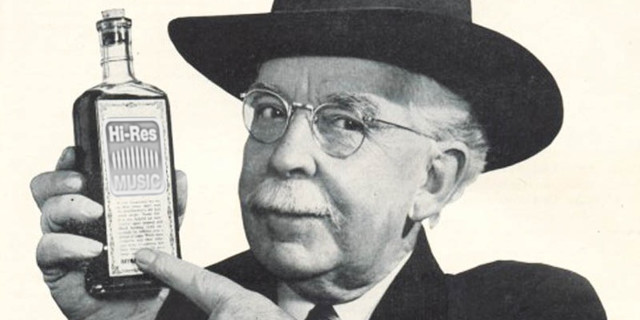Master Quality Authenticated, or MQA, is an audacious innovation in the “high-resolution audio” field, in which record companies try to sell you your music again and audio equipment manufacturers try to sell you things that no human tested in the last century can hear.
Before anything else, we must stress yet again: high-resolution audio makes zero difference at best and causes intermodulation distortion at worst, and even the golden ears advocating this stuff can’t tell the difference from CD quality in A/B/X testing. Hi-res audio is completely made-up bullshit, and anyone trying to sell it to end consumers is committing fraud. The only advantage of hi-res audio is that it tends not to have LOUDNESS WARS mixes.
(24-bit audio — or 32-bit float, just because they can — is routine in recording, because it gives lots more room to mess around or run things through several hundred filters. There’s still no excuse for marketing it at a premium at the far end.)
The goal of this new format is, of course, a rent-seeking monopoly on high-resolution streams for Meridian, the creators of MQA. It’s patented to the hilt, and anyone touching any aspect of it will be required to pay licensing fees every step of the way — unlike Ogg Vorbis or FLAC, which were never patented, or MP3, which is recently patent-free.
MQA offers high-resolution audio with lossy compression. As far as I can work out (corrections welcomed), they take a 24-bit 96kHz stream and compress it into a 16-bit 48kHz stream. All audio from 24kHz to 48kHz is lossily compressed as one frequency band, which is then encoded in the dither of the bottom 3 bits of the 16/48 stream, leaving it effectively a 13-bit stream. There is also another 8-bit 48kHz stream which contains lossily compressed difference between the original 24/96 stream and the 16/48 output stream.
Their secret sauce is better psychoacoustics, though there’s a curious absence of A/B/X test results. (They did get one reviewer literally claiming that “it sounds convincingly better than the normal, non-MQA’d 24bit/96kHz file” that it was created from — meaning that he found MQA’s defects appealing.) They say you can get away with lossy compression because there’s not much energy in the 24–48kHz frequency range. Of course, in strict psychoacoustic terms, you could “compress” it to a single byte containing a zero, because no human tested in the last century can reproducibly hear frequencies over 20kHz. But they claim they are doing this sincerely and have actual data in there and patented innovations and so forth. You wouldn’t be giving them all this money for nothing, after all.
An MQA stream can be packaged as a FLAC, and decoded by anything that can play FLAC (which is everything these days). You can then decode further parts of the stream depending on bandwidth. Of course, the bottom 3 bits contain high-frequency quantised white noise, leaving playback as effectively 13-bit rather than 16-bit — that is, MQA degrades the audio stream if you’re not playing it back with the patented MQA decoder.
MQA has somehow given journalists the idea that it can “deliver files with the size of a typical MP3 download or stream”, which is clearly not going to happen. The precise claim I can find in their own words is “hi-res recordings delivered at just 20% the size of traditional formats” without further numbers — but even the audiophiles willing to entertain the possibility of superhuman hearing ranges aren’t impressed with its efficiency or results:
Note that the original 24-bit signal is never recovered. MQA does not losslessly preserve the original 24-bit signal. For this reason MQA is not truly a lossless system. At best, the MQA system losslessly conveys 17-bits at 96 kHz. Unfortunately this very complicated process is less efficient than lossless FLAC compression of the 17-bit file. It is also only slightly smaller than a FLAC version of the original 24-bit signal. MQA does not make it easier to stream 96 kHz files. With a 96 kHz 18-bit input, FLAC compressed MQA requires higher data rates than FLAC compressed PCM while delivering lower quality than 18-bit losslessly compressed PCM. MQA also requires special mastering and special playback hardware. Conventional FLAC compression requires neither.
The Wikipedia article on MQA is champagne comedy, in which MQA tries to sell a 13-bit 48kHz stream with a couple of lossily compressed correction streams on top as high-resolution, and even other purveyors of audio woo call them out.
What Hi-Fi interview with Bob Stuart of Meridian, in which he inexplicably fails to detail the extensive A/B/X tests irrefutably demonstrating the superiority of MQA.
The RIAA is very into the idea of “Hi-Res MUSIC” — because they want you to buy your collection again — and is heavily pushing MQA in particular, for unclear reasons. RIAA Chief Technology Officer David Hughes says “If I’m in a car and I play an MQA file, it will sound better than an MP3”, as if absolutely anything since 1995 doesn’t sound better than an MP3, e.g. a FLAC in 16/44 CD quality.
Apple Music has shown no signs of caring about even CD-quality streaming, let alone hi-res (despite collecting 24-bit masters for a few years now) and Spotify not much. Tidal has offered MQA on their hi-res tier since January this year, labeling it 24/96 even though it isn’t; there is as yet no data on whether either end user can tell the difference. A cloud of minor download and streaming services have been selling MQAs since last year.
Expect the labels to push this hard. Warner Music signed on last May, Universal in February and Sony and Merlin just this month. There’s a lack of visible product as yet, but Meridian did recruit the CEO of MQA from Warner.
It’s worth reiterating that convenience beats quality, every time. Spotify has become the record industry’s 2017 very best friend while pumping out everything as MP3 and Ogg. On modern pop music, people have trouble telling 16-bit sound from 8-bit sound.
But if you expect people not to call “hi-res audio” fraud: bring reproducible and third-party A/B/X testing or go home. That’s the bottom line and you know that’s the bottom line.
HT Peter Corlett. “Needs more blockchain though.”



Heh. “In a car” he says. Where everything subtle under 200 hz is lost in tyre noise, and everything about 10khz is lost in the wind noise. Most people couldn’t tell CD from FM under those conditions, until the announcer comes on.
You’re wrong on Spotify not being interested in offering lossless streaming?
@Canali – fair enough, they ran some tests in March, though I’ve found nothing new since that.
edit: changed article accordingly
Anonymous comment claiming to be from a manufacturer on an audiophile site
What the hell? You are really going to say that hi res audio makes no difference? 16 bit music format such as the CD downgrades and squares off the wave forms, and includes added noise called dithering to keep the signal from distorting. Where do you possibly get that HI RES adds more noise? Where is this said noise conning from?
There is very much a noticeable difference in hi res music especially in stringed and wind instruments.
I literally set out what it’s doing – they cut three bits off the bottom to encode another signal in.
You don’t appear to understand how digital audio works. Read more Monty.
And, to quote the last line: bring reproducible and third-party A/B/X testing or go home. That’s the bottom line and you know that’s the bottom line.
Loren,
You seem to be intuiting a model of digital audio based on 1980s and earlier designs where silicon was expensive and corners were cut. If you hook up a scope or other signal analyser and see staircasing or square-wave noise, somebody screwed up the filter design, and the blame for that flaw lands firmly on the analogue side.
As to dither, it is only “noise” in a very special technical sense. It is broadly similar to feeding bits 17 downwards into a delta-sigma (aka “1 bit”) DAC, and then adding the single bit output to the normal 16 bit PCM signal. Practical implementations will tend to use a better reduction function than delta-sigma.
However, dithering a 16 bit signal is already basically just showing off because we now have the technology to produce and measure it, and it’s imperceptible except in contrived circumstances. Dithering comes into its own when, for example, some snake-oil peddling berk truncates the signal to 13 bits and puts proprietary noise in the LSBs before adding a thick layer of marketing bullshit. (And I’m perhaps being charitable in assuming they competently dither the 13 bit signal.)
An ABX test using MQA-encoded files is obviously going to favour MQA; so would comparing the output of an MP3 decoder versus treating the MP3-encoded data and playing that as PCM. A valid ABX test would be to take the original 24/96 source and do a high-quality downconversion into MQA and PCM. Signal theory would suggest that PCM is the more accurate representation, although in practice I’d expect nobody to hear a damn bit of difference between the two. So it ultimately comes down to the practical considerations of a DRM-free file that plays well everywhere versus one that requires a proprietary player to not sound bad, which is very much a no-brainer.
Edit to article: Since my blunt statement concerning no human tested in the past century, a few people have pointed me at individual studies. I urge a reread of the bit of Monty’s article where he points out that these studies consistently fail to reproduce, and explaining just how easy it is to mess up experiments on this stuff. (In particular, just how many places you can accidentally introduce intermodulation distortion.) And how he doesn’t do a damn thing without A/B/X testing it.